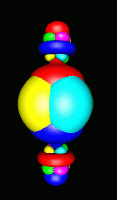Nobel Focus: Chemistry by Computer

The 1998 Nobel Prize in chemistry recognizes two researchers whose work has allowed chemists to calculate the properties of molecules and solids on computers, without performing experiments in the lab. The basic principles of the calculation scheme were first described in Physical Review in the 1960s, and solid state physicists used them for decades before they became important in the chemistry world. The scheme drastically simplifies the solution of the quantum mechanical equations for a system of many electrons, and although approximate, the solutions are accurate enough that chemists can learn about large molecules without getting their hands wet.
All of the chemical properties of molecules and electrical properties of solids are determined by electrons interacting with each other and with atomic nuclei. By 1930 physicists were fully aware of the quantum mechanical equations governing systems of many electrons, but were incapable of exactly solving them in all but the simplest cases. They developed several approximation schemes, but none was very successful. In 1964 Walter Kohn, now of the University of California at Santa Barbara, and Pierre Hohenberg, now of Yale University, proved an idea that was central to their solution scheme, which is now called density functional theory (DFT). They showed that knowing the average density of electrons at all points in space is enough to uniquely determine the total energy, and therefore all of the other properties of the system. Other available methods at the time required wave functions, which depend on the positions of every electron in the system and are far more complicated functions than the density.
Kohn’s 1965 publication, with Lu Sham of the University of California at San Diego, described a procedure for deriving the electron density and energy, based on solving equations for a corresponding system of noninteracting electrons, which is much easier to manage. The trickiest part of the scheme is the starting point: One has to assume a relationship (called the “density functional”) between energy and the density function. The explicit form of the density depends on the problem, but Hohenberg and Kohn proved in the earlier paper that in principle there exists a universal density functional, good for all problems. Kohn and Sham provided a simple approximation of this relationship, and it has served solid state physics for decades, allowing for most modern calculations of the “band structure” of electrons in solids, for example. But the approximate density functional used by Kohn and Sham was not accurate enough to calculate chemical bond energies and structures of molecules, so experimental chemists had little use for it.
Beginning in the late 1980s, however, physicists began modifying the Kohn-Sham density functional in ways that improved its accuracy. In 1992 John Pople, of Northwestern University in Evanston, IL, added DFT–including the latest functionals–to his widely-used chemistry computer program GAUSSIAN. The program was already recognized as the premier tool for studying structures and chemical reactions, at least for small molecules, but with the addition of DFT, chemists were immediately impressed with its accuracy and speed. Since then biochemists, drug designers, atmospheric chemists, and even astrophysicists have benefited from studying complex molecules and reactions by computer.
Kohn and Pople received the Nobel Prize in chemistry for their contributions to computational chemistry, which is now used routinely as a tool by scientists in many fields. Kieron Burke, of Rutgers University in Camden, NJ, says Kohn’s DFT was a brilliant simplification of the quantum mechanical mathematics. “This is one of the greatest free lunches ever,” he says, because it saves computer time (allowing for calculations with larger molecules) and requires in exchange only that the user provide a single, approximate density functional.
Announcement and background from the Nobel Foundation


